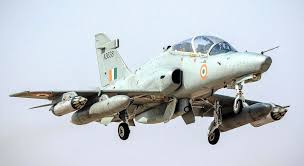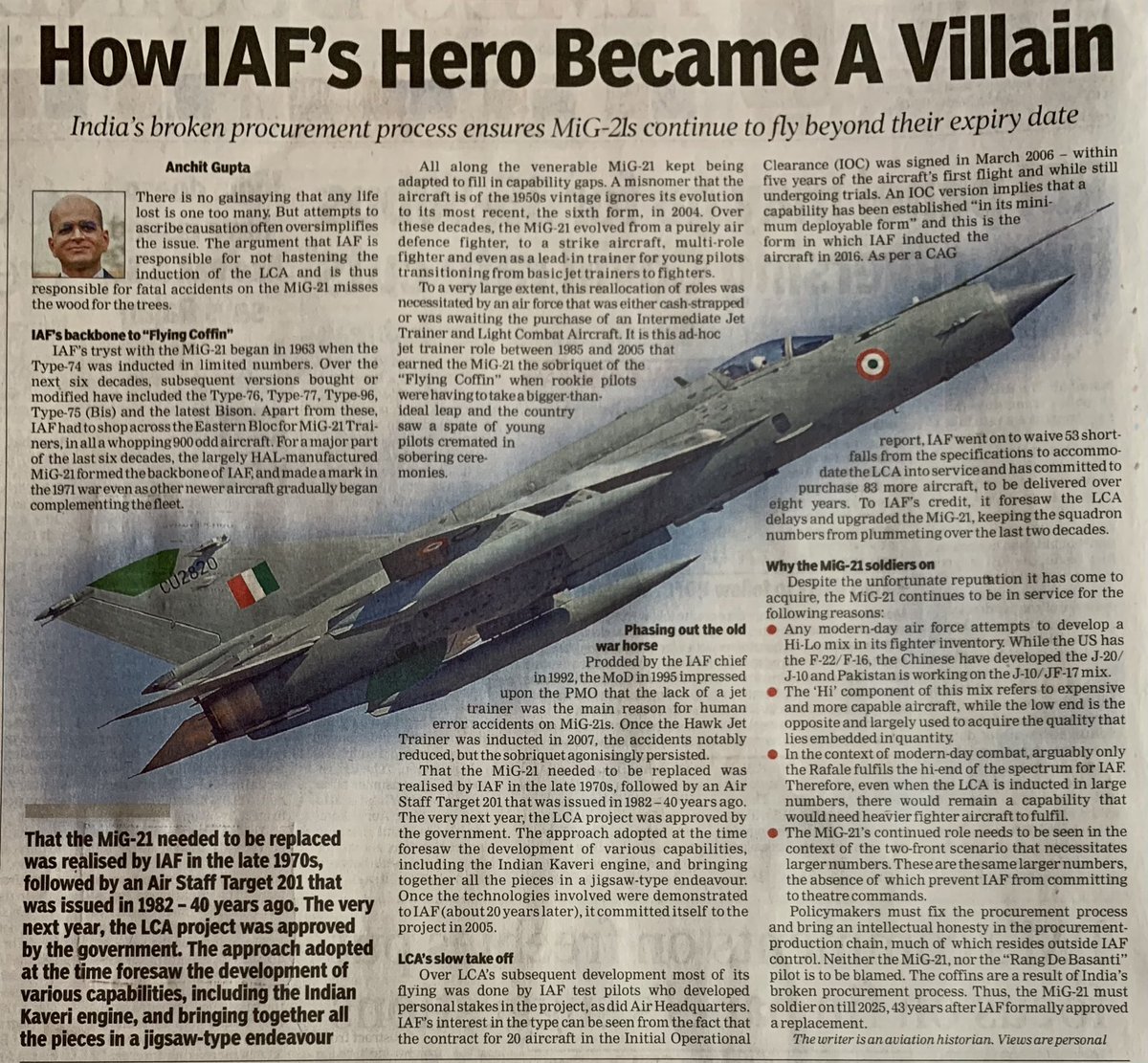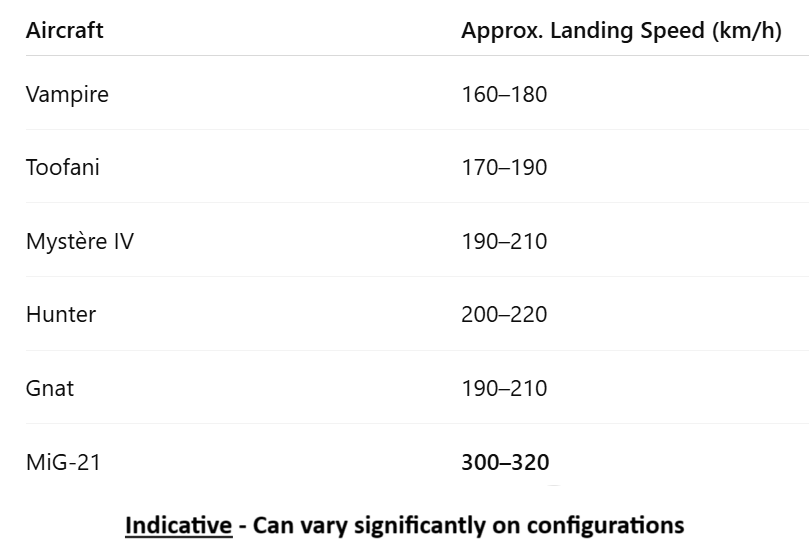History of the 114 Helicopter Unit - the “Siachen Pioneers”, an @IAF_MCC unit that has been continuously in ops the longest amongst all services,regularly faced nature,enemy fire & lost its own during peace. It remains a unique unit in the world of aviation. #IAFHistory (1/34) 
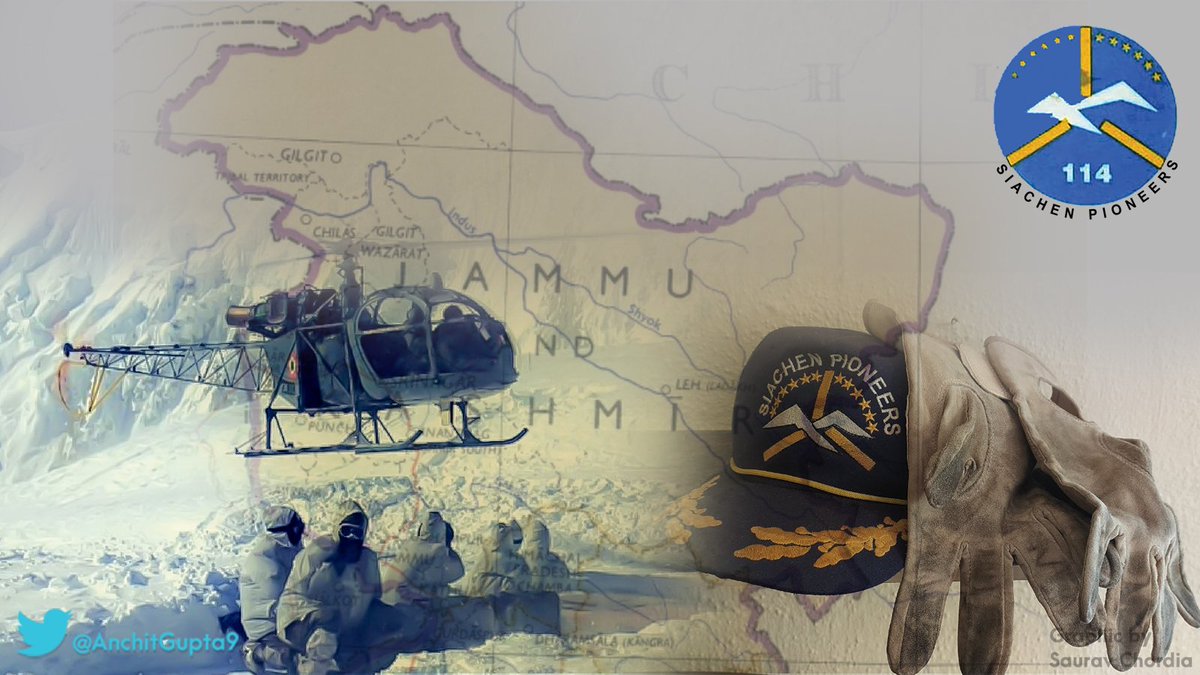
Approved as the 1st all Chetak unit on 18 Dec 62 with an estb of 8 heptrs, 114 HU was raised on 1 Apr 64 with two a/c & was based at Leh – replacing 107 HU’s Mi-4 dett stationed since the ‘62 war. 114 was the 1st permanent IAF unit at Leh where it continues to this day. 2/ 

Sqn Ldr Arvind Dalaya moved in to take command. Other than pilots converting from Mi-4s, the unit also had 5 pilots from 83 PC who had directly been commissioned in Heptrs after trg in France. The unit made Leh-Srinagar-Jammu as its permanent home for next two decades 3/ 
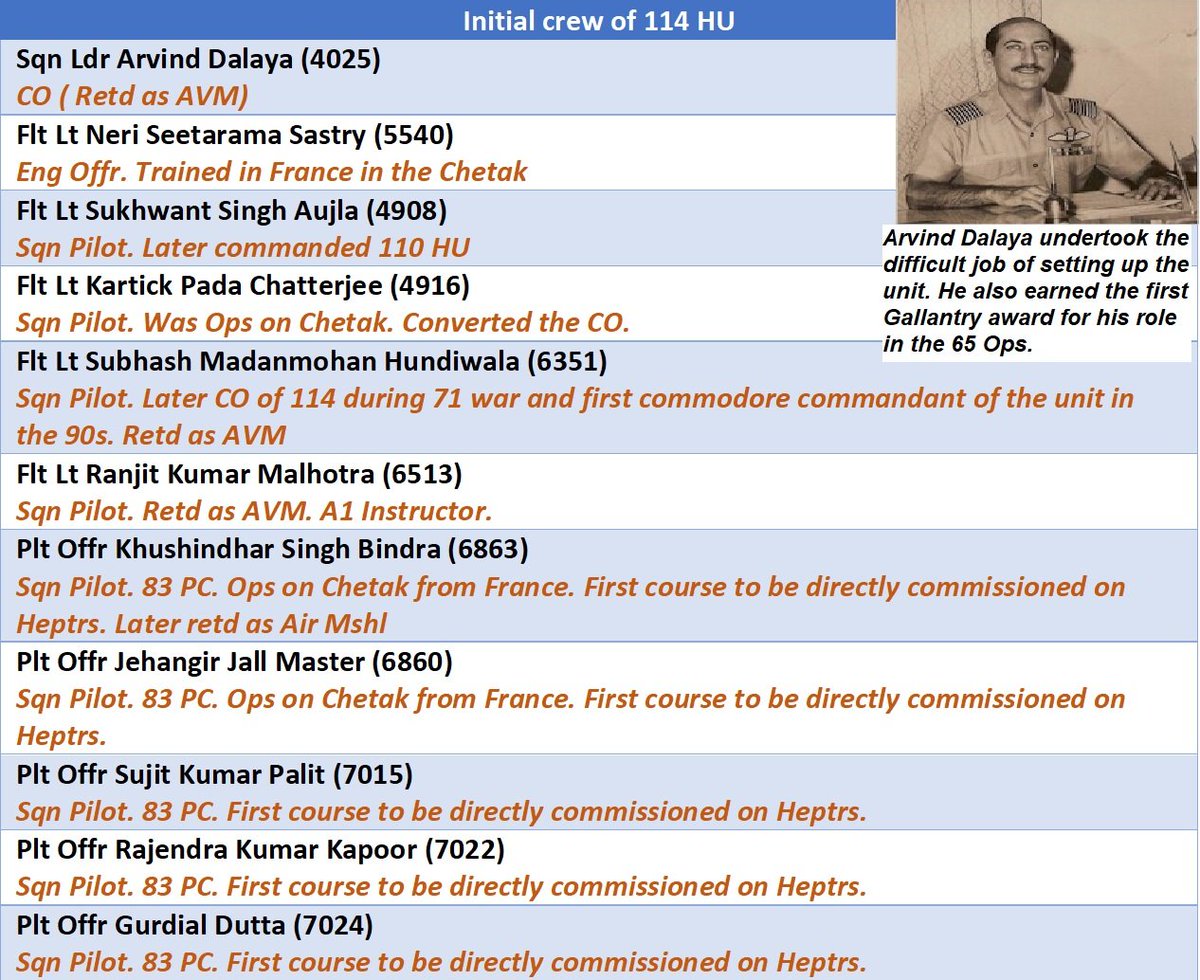
Its initial steed, the French Alouette III was chosen for it was nimble, lighter, reliable & had more reserve of power, even if lower carrying capacity. It’s a tribute to the design that the a/c continues to serve across the globe in its upgraded avatars. 4/ 

Ironically, its service ceiling of 10,500 ft (Wiki) is nearly the elevation of Leh. It should thus never even have taken off from Leh,but then that is the story of 114– grit, derring do & gallantry on a daily basis!The journey was however not easy & costs had 2 b paid. 5/ 

Early on the unit got a taste of the hardship & courage the area demanded. An a/c crashed while crossing Khardungla when its engine failed, while another had to be force landed at Murgo (16000 ft). Engine changes in remote locations were common. 6/ 

During the ’65 war, 114 engaged in CasEvac & mercy msns, flg some Chetaks with a Red Cross livery. Over 81 hours of flg, 80 were evacuated mostly from Charwa & Haji Pir. VIP sorties & Int gathering msns were also flown. One a/c was also damaged by shrapnel during a raid.7/ 

Btwn the 65 & 71 wars, the Unit estb grew to 10 heptrs, incl a dett at Baramulla that gave aerial access to the Haji Pir area. Ladakh however remained 114’s primary area of op. In Aug 68 a Heptr from 114 cleared the Chandigarh-Kulu-Keylong-Leh route- a 1st for the IAF! 8/ 

’71 War saw the unit again perform Casevac and mercy msns amidst enemy fire mostly in Kargil & Uri sectors. On 5 Dec, a Heptr flown by F/L BS Chandel & F/O SS Ramarao was shot down by F-86 near the Srinagar airfield. Both miraculously survived. 9/
On 11 Dec, S/L KL Bajaj & F/O RR Patel flg Kargil-Dras ducked into a valley to avoid shelling & hit HT cables. Bajaj lost his life in the accident. The unit also earned 2 VrCs - Bartan Ramesh for his 45 msns & Sukhdev Dhillon for 87 Casevacs, with disregard to pers safety. 10/ 
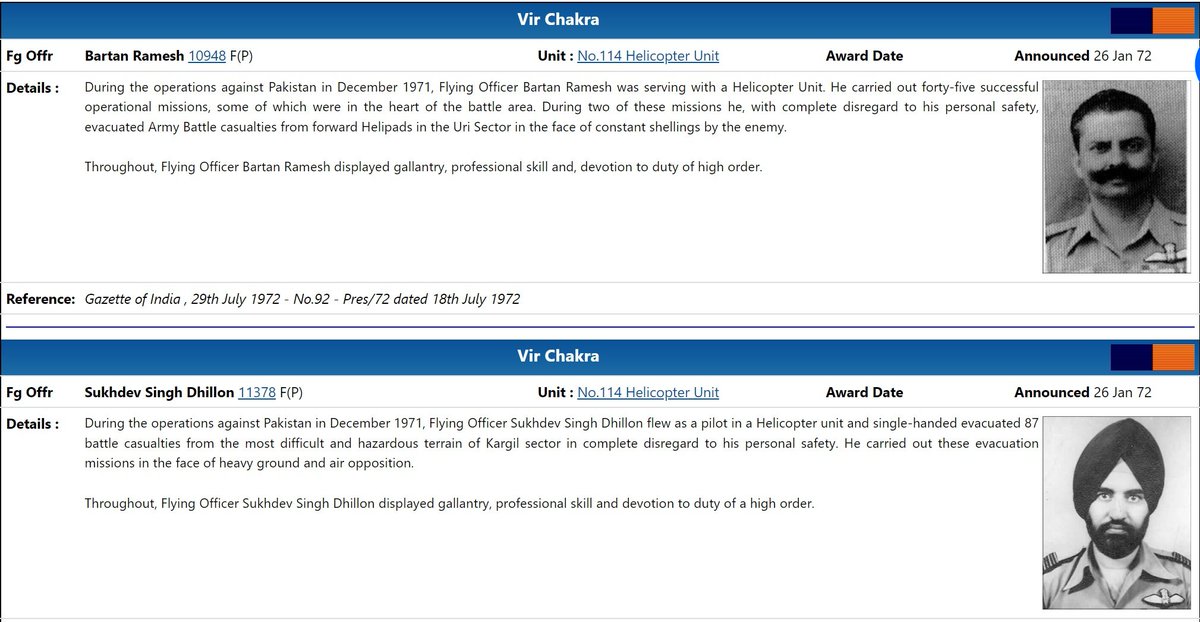
After the War, the unit was given an addl role & equipped with the AS-11B Anti-Tank guided Missile in some of its Chetaks. This role cont till about ’87, by when 114 HU had already made their tryst with destiny. This involved a certain area called "the place of wild roses”. 11/ 

Prior to his epic expedition to the Siachen, Col “Bull” Kumar flew an aerial recce over the area on 03 Aug 78, with S/L Sambyal & F/L AS Mann pioneering the IAF’s forays over the world’s “3rd Pole”. The ‘Glacier Pioneers’ had ‘boldly gone where no pilot had gone before’. 12/ 

In 1985, 114 HU was called the “Glacier Pioneers”. Around 1990, this name was changed to “Siachen Pioneers” which sticks to date, as they remain the avant-garde of helicopter flying. But first, let’s return to the pioneering days... 13/ 

The 1st supply msn to Siachen followed in Sep 78. S/L Monga & F/O @BahadurManmohan then landed on the glacier on 6 Oct 78 in Z-1410. This ldg at 15,500 ft was a feat that has not been ack as it should have. Siachen had been saved…6 yrs before Op Meghdoot was announced. 14/ 

In between, the unit continuing its “civil aid” role had earned unprecedented laurels, incl a record 5 Shaurya Chakras for daring rescue msns. 4 of these were for mountain rescues & the 5th for RS Tandon’s fearless post- snow storm rescue in Antarctica. 15/ 

The Govt-auth’d Op Meghdoot to secure Siachen was formally flagged off on 31 Mar 84. However, 13 Apr is often ascribed to be the start - being the date when IA troops reached Bilafond La which is at the foot of Amar & Sonam - the record-breakingly high helipads in the area. 16/ 

114 started recce of Siachen by end-Mar 84, inducting troops to the 5-6 camps estd by the IA. Drops were executed short of Sia La/ Bilafond La & CasEvac was undertaken on beaten snow. On 13 Apr, IA troops were dropped at Bila, where much blood from both sides was to be spilt. 17/ 

Siachen is ~ 70 km long & has subsidiary glaciers to the West which terminate into passes (La’s) that overlook lower Pak Army posns- Sia La & Bilafond La being the 2 main one. Whilst it may be able to observe certain areas, it is a canard that the Pak Army was ever on Siachen.18/
In 1981, CAS Latif noticed the AOP flg the lighter Cheetah in Darbuk. He ordered an imm change of type for 114 too, resulting in the unit getting its first 2 Cheetahs. For next 6 yrs they flew both types, becoming a Cheetah-only unit in 1987, thus also losing their ATGM role. 19/ 

This was a welcome change since Siachen poses unique challenges. The crevassed terrain offers few ldg spots. Wind speeds, turbulence, temperatures & clouding can be extreme. But of all the natural elements, it is the altitude & lack of O2 which affects man & machine the most.20/ 

In Siachen, it is the Density Altitude (DA), not the Pressure Alt that dictates a/c behavior. In layman’s terms, it is the “alt where, perf-wise, the a/c thinks it's at”. The usually higher DA is debilitating for a/c perf. Avgeeks can visit tinyurl.com/3ufx4cd2 for more. 21/ 

Flg at the limits of a/c perf necessitates careful calc of ‘All up Weight’ of the a/c. For a Cheetah flg here a few extra kg of ration can have lethal effects. A “jugaad” calculator was thus created by the Pioneers & taped up to the instrument panel. 22/ 
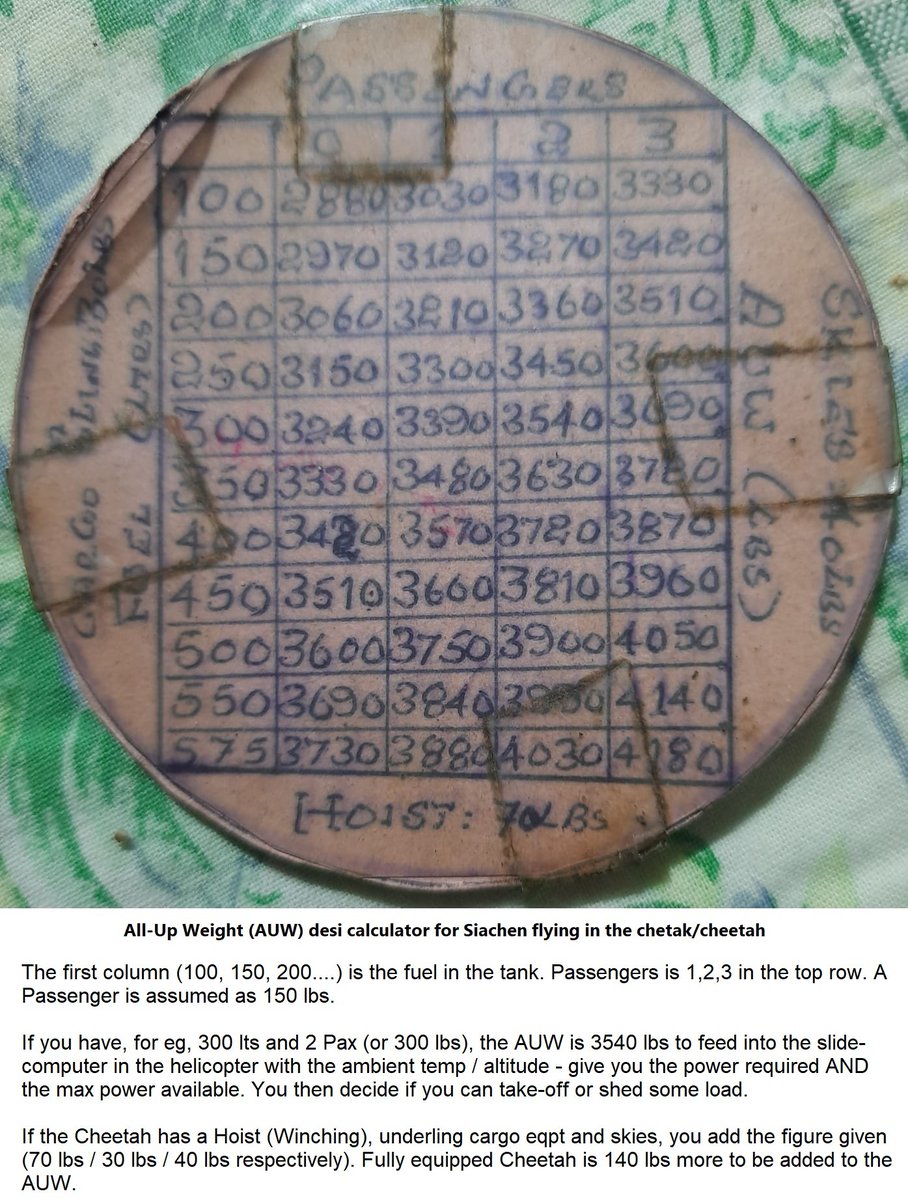
Siachen had Camps I, II, III (later named Kumar), IV & V. Bilafond La, Bhim, SiaLa, G3, Zulu, Hoshiar were on 'branches'. Soman, Amar, Khanda, Ravi helipads started in ’85 & were all at 15k -19.5k feet elevation! These were & still are forbidding heights by any measure. 23/ 

The matchbox-sized helipads appearing to be on pillars add to the pilots’ conundrum. Some weather conditions create a ‘White Out’ akin to being inside a pingpong ball, whereby all depth perception is lost. When there are no clouds, the glare from the snow hurts the eyes. 24/ 

A coveted qualification (patch introduced in the 2000s), it takes some doing to be a Captain on the Glacier (Champ of champs). A 7-8 month effort, Co-Pilot flying hrs to the highest helipads, conversion and clearance by a QFI, followed by flying as Captain. 25/ 

If the terrain, weather & altitude weren’t sufficient challenges, this was an active warzone where enemy firing was common. In the pd between 1985-2000, 114 HU personnel earned 2 Vir Chakras and 5 Yudh Seva Medals apart from scores of VMs/VSMs and Commendations.26/ 

Flying at the edge of the envelope came with risks. Several a/c were lost, some taking their pilots. Some were hit by enemy fire, sometimes causing injury, but 114 soldiered on. Their awards’ citations are hair raising & everyone joined in-from Corporal to CO! 27/ 

The 114 spirit is best understood in the aftermath of an engine malfunction after ldg at Amar (19500 ft) on 3 July 90. The 182 kg engine was reqd to be changed at the helipad manned by the Sikh LI who physically moved the a/c to make way for the recovery heptr. 28/ 

A tech team led by the 114’s F/L Sreepal was chosen for the job,while the CO, W/C Goli himself flew up the engine in a stripped a/c without a battery! His ldg was greeted by the Pak Army.Sreepal & the Sikh troops changed the engine,with regular music coming from the Pak Army. 29/ 

On 13 July, S/L Sinha (later VrC in Kargil) & F/L Malhi were landed at Amar to recover the a/c. Luck favours the brave & the engine started in one go. The ldg at Base Camp was followed by rejoicing. The unit had pulled off an impossibility, one that skyrocketed the morale! 30/ 

It is said that one must be either crazy or posted in 114 HU to fly single engine heptrs over Siachen. The Unit’s spirit is best embodied in it’s motto of “We do the difficult as a routine, the impossible may take a little longer”. 31/ 

In 1996, 114 HU was awarded the President’s Standards, fittingly under the command of then-Wg Cdr @BahadurManmohan who had earlier been on the first a/c to have landed on Siachen & was later SO to CAS Tipnis during the Kargil War + Commodore Commandant of 114 HU. 32/ 

114 soldiers on at its Karmbhoomi-now flg an up-engined Cheetal. The a/c & crew have changed but the spirit remains the same. What struck me the most while researching this thread (took some doing) was the reticence of ex Pioneers-they all feel they were just doing their job! 33/ 

I am grateful to AVM @BahadurManmohan & Wg Cdr Raju Srinivasan for their untiring support in the research work as also the MOD History Division that has thrown open its doors to independent researchers. 34/ 

• • •
Missing some Tweet in this thread? You can try to
force a refresh


